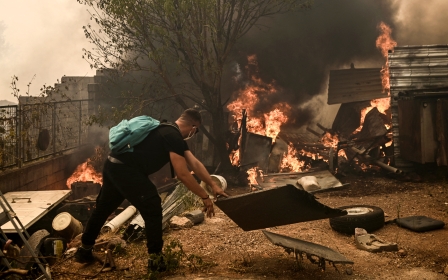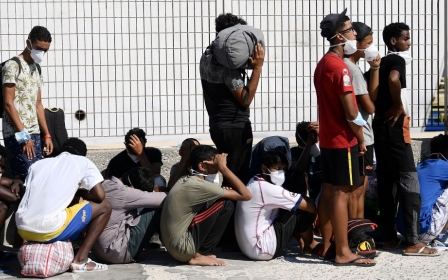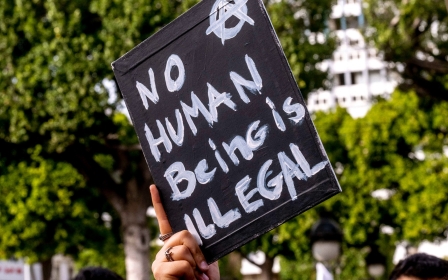Italy closes Lampedusa asylum 'hotspot' as 7,000 refugees arrive in 24 hours

The Italian authorities closed a reception "hotspot" in Lampedusa after 7,000 refugees arrived in 24 hours on Wednesday, according to the NGO Sea-Watch.
Thousands of migrants were being held in what NGOs have condemned as “deliberately inadequate and inhumane” facilities, where they were reportedly denied water and medical treatment amid soaring temperatures.
Lampedusa, a small island that sits in the Mediterranean between Tunisia, Malta and Sicily, is the main entry point for many refugees seeking to reach the European Union.
Video footage posted on social media revealed crowds of predominantly sub-Saharan Africans being herded by Italian police with riot shields and batons.
But Sea-Watch told Middle East Eye that on Wednesday the authorities “abandoned” the centre, leaving the local community to provide food and water to the detainees.
Stay informed with MEE's newsletters
Sign up to get the latest alerts, insights and analysis, starting with Turkey Unpacked
“The authorities completely pulled out,” Tamino Bohm, tactical coordinator of Sea-Watch airborne, told MEE. “[They are] doing very, very basic stuff and people are self-organising [to provide aid].”
The hotspot, which was intended as a temporary reception facility, has faced dramatic overcrowding in recent months, accommodating people at eight times its capacity.
Following a visit in June, the UN refugee agency UNHCR and the United Nations' Children’s Fund (Unicef) called on the Italian authorities to ramp up transfers from the hotspot to better-equipped facilities across the country.
“People should only be there for a short time, and get shipped to Sicily,” Bohm told MEE. "[It became] a prison. All summer round there were 1-2,000 people in the hotspot, which is meant to be for 395 people.”
People are drowning
Over 84,300 people arrived by sea in Italy between 1 January and 23 July, a 144 percent increase on the previous year. Of these, 66 percent landed on Lampedusa, compared with 48 percent in the same period of the previous year.
For Sea-Watch, whose aerial surveillance mission monitors human rights abuses in the central Mediterranean, the influx is unprecedented.
“Since the beginning of our organisation, never ever have we seen so many people arrive in one day,” Sea-Watch spokesperson Felix Weiss told MEE.
The uptick is partly due to a surge in arrivals from Sfax in Tunisia, overtaking Libya as the primary departure point for refugees attempting to cross the central Mediterranean to Europe.
According to UNHCR data, in the first three months of 2023, 58 percent of refugee sea crossings departed from Tunisia.
“I wouldn’t say Tunisia is the new migration hub, but we are definitely seeing a change in migration route,” Weiss said.
'We are definitely seeing a change in migration route'
- Felix Weiss, Sea-Watch spokesperson
A wave of anti-black violence, unleashed by racist comments made by Tunisian President Kais Saied, has spurred a surge in sub-Saharan Africans fleeing the country.
Since then, black migrants in Tunisia have faced eviction, unemployment, arbitrary detention and collective expulsions to the desert border with Libya.
“It has become incredibly dangerous for people from sub-Saharan Africa to stay in Tunisia,” Weiss told MEE.
While the crossing from Tunisia to Italy is shorter than the route from Libya, it is more deadly, partly due to a poorer quality of iron boat used on the route.
“These boats are incredibly dangerous… whenever there is a leak or a big wave, people are drowning,” Weiss said.
According to Weiss, over the past two months the route has become so busy that SeaWatch is unable to cover it. The prevalence of the iron boats also complicates the NGO's ability to detect people in distress, as the vessels are hard to distinguish from one another.
The arrival of the flotilla at Lampedusa comes after Tunisia and the EU signed a controversial €1bn migration pact, a partnership that has been condemned by Médecins Sans Frontières for making the EU “directly complicit in the ongoing abuse and deaths of people trapped in the country”.
However, on Thursday, Tunisian authorities denied entry to five members of the European Parliament (MEPs), in what the latter described as a “slap in the face for diplomacy”.
For Weiss, the fraught negotiations could have influenced the uptick in arrivals on the island.
“We think the Tunisian coastguard was letting boats pass,” Weiss told MEE. “The money is not flowing to Tunisia right now… we think that maybe the Tunisian government has used this as an opportunity to create pressure.”
A self-produced crisis
In Italy, images of queues of flimsy boats waiting to dock and reception facilities bursting at the seams elicited fury on social media, with many raising the alarm about an “armada of Africans” invading the island.
But the online hysteria contrasts almost comically with the situation described by Bohm, who is on the ground in Lampedusa.
Once the authorities abandoned the centre, one that was previously heavily guarded by military personnel, the detainees were left to wander the town, mingling peaceably with tourists, with locals providing food and water.
“It’s actually very peaceful and calm,” Bohm told MEE.
A video posted online revealed refugees and locals dancing together to a Bob Marley cover band; a moment of profound catharsis after years of segregation.
“The fact that people can move freely in Lampedusa and are not locked up is a big step,” Bohm said. “It’s a different situation to a few weeks ago, when at times 5,000 people would arrive in a day, and everyone gets locked up and you can see no one.”
For Sea-Watch, the situation at Lampedusa is “self-produced” - a product of the managed decline of the Italian asylum system.
According to Bohm, the influx was easily predictable.
“This is not a new phenomenon,” he said. “Every time you have good weather, you have people coming. If there’s bad weather [just] before, you have a traffic jam.
“We fly in more people to be able to react to the situation,” Bohm said. “If the Italian authorities were to do this, for example by bringing a ferry in advance… the situation would be completely different.”
Middle East Eye delivers independent and unrivalled coverage and analysis of the Middle East, North Africa and beyond. To learn more about republishing this content and the associated fees, please fill out this form. More about MEE can be found here.





